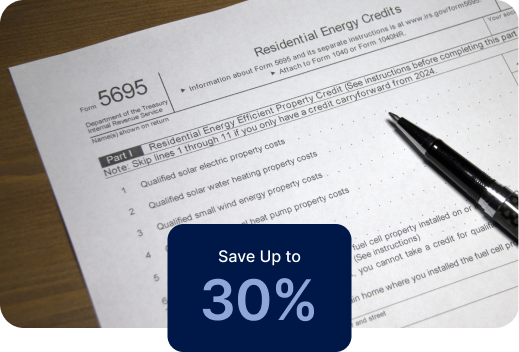The renewable energy sector continues to expand, despite policy uncertainty under the Trump administration.
Georgia Solar Incentives: 2025 Overview
Georgia provides valuable incentives to make solar energy affordable. Residents can take advantage of the 30% Residential Clean Energy Credit, which reduces installation costs, and the net billing program allows homeowners to earn credits for excess energy, lowering future bills. With additional financing options available and Georgia’s sunny climate, going solar is a cost-effective way…

Residential Clean Energy Credit
The Clean Electricity Investment Credit (previously called the Federal Investment Tax Credit) helps lower the cost of installing solar panels by 30%. This credit covers everything: the solar panels, equipment, labor, permits, and even sales tax.
For example, as of 2025 the average cost of a 10 kW solar system in the U.S. typically ranges between $21,000 and $29,500 before applying any federal tax incentives. After claiming the 30% Clean Electricity Investment Credit, the price drops to around $14,980 to $21,070, depending on the state and other factors like equipment quality and labor costs.
To claim this credit, you must buy your solar system with cash or a loan (leases don’t qualify). You also need to owe enough in taxes to claim the credit, but if you don’t, you can carry it over to future years until 2034.

Claiming the Clean Electricity Investment Credit is simple!
Step 1
Print IRS Form 3468
Step 2
Fill out the form using info from your installer
Step 3
Submit it when you file your taxes
What are the top solar incentives in Georgia?
Besides the Clean Electricity Investment Credit (former ITC), homeowners can take advantage of several outstanding incentives that significantly enhance the return on investment for solar panels. Here are some of the most effective ways to lower your solar installation costs.
Incentive
Savings
Summary
Residential Renewable Energy Tax Credit
A taxpayer may claim a credit of 30% of qualified expenditures, after deducting incentives, with no upper limit for a system that serves a dwelling unit located in the United States that is owned and used as a residence by the taxpayer. Expenditures with respect to the equipment are treated as made when the installation is completed. If the installation is at a new home, the “placed in service” date is the date of occupancy by the homeowner. Expenditures include labor costs for on-site preparation, assembly or original system installation, and for piping or wiring to interconnect a system to the home. If the federal tax credit exceeds tax liability, the excess amount may be carried forward to the succeeding taxable year. The excess credit may be carried forward until 2019, but it is unclear whether the unused tax credit can be carried forward after then.
Residential Renewable Energy Tax Credit
A taxpayer may claim a credit of 26% of qualified expenditures, after deducting incentives, with no upper limit for a system that serves a dwelling unit located in the United States that is owned and used as a residence by the taxpayer. Expenditures with respect to the equipment are treated as made when the installation is completed. If the installation is at a new home, the “placed in service” date is the date of occupancy by the homeowner. Expenditures include labor costs for on-site preparation, assembly or original system installation, and for piping or wiring to interconnect a system to the home. If the federal tax credit exceeds tax liability, the excess amount may be carried forward to the succeeding taxable year. The excess credit may be carried forward until 2020, but it is unclear whether the unused tax credit can be carried forward after then.
Residential Renewable Energy Tax Credit
A taxpayer may claim a credit of 22% of qualified expenditures, after deducting incentives, with no upper limit for a system that serves a dwelling unit located in the United States that is owned and used as a residence by the taxpayer. Expenditures with respect to the equipment are treated as made when the installation is completed. If the installation is at a new home, the “placed in service” date is the date of occupancy by the homeowner. Expenditures include labor costs for on-site preparation, assembly or original system installation, and for piping or wiring to interconnect a system to the home. If the federal tax credit exceeds tax liability, the excess amount may be carried forward to the succeeding taxable year. The excess credit may be carried forward until 2021, but it is unclear whether the unused tax credit can be carried forward after then.
Residential Renewable Energy Tax Credit
A taxpayer may claim a credit of 30% for the installation which was between 2022-2032 (Systems installed on or before December 31, 2019 were also eligible for a 30% tax credit), with no upper limit for a system that serves a dwelling unit located in the United States that is owned and used as a residence by the taxpayer. Expenditures with respect to the equipment are treated as made when the installation is completed. If the installation is at a new home, the placed in service date is the date of occupancy by the homeowner. Expenditures include labor costs for on-site preparation, assembly or original system installation, and for piping or wiring to interconnect a system to the home.
Solar PV Rebate
Cobb EMC has long encouraged the efficient use of electricity and renewable energy technologies. To make installing and generating electricity from photovoltaic systems more affordable, Cobb EMC offers rebates to members.If a residential Cobb EMC member chooses to install a qualifying photovoltaic system on their home, the rebate will help to offset a portion of the initial installation cost of the system. Members who qualify for the program are eligible to receive a one-time rebate of $450 per kilowatt AC (kW) installed, up to 10 kW. Limited funds are available. Rebates will be given on a first-come, first-served basis.
Solar Power Home Rebate (PV)
Jackson Electric Membership Corporation (Jackson EMC), which serves over 185,000 residential customers, offers rebates to those customers who install photovoltaic (PV) systems. In exchange for these incentives, Jackson EMC retains the rights to any renewable energy credits (RECs) associated with the energy production of these systems. Residential customers may qualify for the one-time rebate of $450 per kilowatt (kW) of DC installed, up to 10 kW. In order to qualify, they must select a trained and certified North American Board of Certified Energy Practitioners (NABCEP) contractor to install the system, which must be certified by the Florida Solar Energy Center. In addition, the customer’s system must meet Jackson EMC requirements and be pre-approved for interconnection and net metering.
Solar Power Home Rebate (PV)
Jackson Electric Membership Corporation (Jackson EMC), which serves over 185,000 residential customers, offers rebates to those customers who install photovoltaic (PV) systems. In exchange for these incentives, Jackson EMC retains the rights to any renewable energy credits (RECs) associated with the energy production of these systems. Residential customers may qualify for the one-time rebate of $250 per kilowatt (kW) of DC installed, up to 10 kW. In order to qualify, they must select a trained and certified North American Board of Certified Energy Practitioners (NABCEP) contractor to install the system, which must be certified by the Florida Solar Energy Center. In addition, the customer’s system must meet Jackson EMC requirements and be pre-approved for interconnection and net metering.
Photovoltaic (PV) Rebate Program
In June 2008, Central Georgia Electric Membership Corporation (CGEMC) began offering a rebate of $450 per kilowatt (kW) to residential members who install photovoltaic (PV) systems that are interconnected and net-metered. To qualify, PV systems must have a warranty of five or more years and must be installed by a licensed contractor. In addition, PV systems are limited to 10 kW AC per household in capacity and must be installed in accordance with all applicable building and national electric codes. Because Central Georgia EMC reserves the right to modify or cancel the program at any time without prior notification, interested members should contact Central Georgia EMC to ensure that a specific project is eligible for this incentive.
Residential Photovoltaic Rebate Program
It’s highly reliable and needs little maintenance.PV solar cells are an environmentally safe technology that converts sunlight directly into electricity.By using a renewable source of power, such as sunlight, you help ensure our energy future by tapping into an infinite power supply.It’s produced domestically, strengthening our economy.It’s modular and thus flexible in terms of size and applications.It helps meet the demand and capacity challenges facing many energy service providers.It serves both form and function in a building.
Residential Photovoltaic Rebate Program
It’s highly reliable and needs little maintenance.PV solar cells are an environmentally safe technology that converts sunlight directly into electricity.By using a renewable source of power, such as sunlight, you help ensure our energy future by tapping into an infinite power supply.It’s produced domestically, strengthening our economy.It’s modular and thus flexible in terms of size and applications.It helps meet the demand and capacity challenges facing many energy service providers.It serves both form and function in a building.
Solar Photovoltaic (PV) Rebate Program (Closed)
GreyStone has long encouraged and supported the wise and efficient use of electricity. GreyStone also supports the proper application and use of reliable renewable energy technologies. To help encourage the adoption of these proven resources, GreyStone is offering a rebate to help make installing and generating electricity from photovoltaic systems more affordable for members. If a residential GreyStone Power member chooses to install a qualifying photovoltaic system on their home, the rebate is designed to help offset a portion of the initial installation cost of the system. Members who qualify for the program are eligible to receive a one-time rebate of $450 per kilowatt AC (kW) installed, up to 10 kW.
Solar Photovoltaic (PV) Rebate Program (Closed)
GreyStone has long encouraged and supported the wise and efficient use of electricity. GreyStone also supports the proper application and use of reliable renewable energy technologies. To help encourage the adoption of these proven resources, GreyStone is offering a rebate to help make installing and generating electricity from photovoltaic systems more affordable for members. If a residential GreyStone Power member chooses to install a qualifying photovoltaic system on their home, the rebate is designed to help offset a portion of the initial installation cost of the system. Members who qualify for the program are eligible to receive a one-time rebate of $450 per kilowatt DC (kW) installed, up to 10 kW.
Disclaimer: The information provided here regarding solar incentives, tax credits, and rebates is for general informational purposes only and may vary based on your specific circumstances. For exact details, eligibility requirements, and current rates, we recommend consulting a certified solar installer or a tax professional. Incentives can differ by location, utility provider, and individual project, so it’s important to get personalized advice for your solar installation. Always verify the most up-to-date information from your local solar installer to understand how these incentives apply to your project.
Knowledge Base
Find everything you need to know about solar in your state and nationwide

Get a Quote
Discover the Ideal Solar System for Your Home in Just a Few Clicks!







